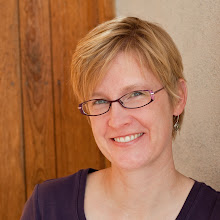I did a little experiment a few months ago and wanted to show you the results. I wove these four little samples on a Hokett loom. Speed of warping is a big advantage when you're making samples. Hokett looms are warped in a flash.
I wove these samples with the same weft at 8 ends per inch. The warp was different for each. All four warps were cotton seine twine made by Bockens. The sizes are woven into the samples. 12/15 is the fattest, 12/9, 12/6, and 20/6 is the thinnest. They also make a 12/12 warp which falls between the 12/15 and the 12/9. I didn't have any at the time.
I wove these because my normal weaving practice of 8 to 10 epi with a 12/6 warp doesn't fit the parameters often given for warp and weft sizes. I'd like to suggest that there is a much wider range of possibilities than has been taught in all the basic tapestry texts.
There are many guidelines for figuring out what warp to use. One such authority is Archie Brennan and THIS article on the American Tapestry Alliance website is used a lot.
Archie is certainly correct that the space between the warps is very important. My argument is that when you change that space, you get different effects in your weaving. Most tapestry weavers that I know work closer to the 12/15 side of things. You can see fairly clearly in my photo that the warp ribs in the 12/15 sample are very prominent. We'd expect this from a fat warp. The warp I use the most at this sett is the 12/6. The warp ribs are much less prominent and the surface of the tapestries is smoother. This is something that I like in my work. I also use a weft yarn that is slightly fuzzy and it gives the surface a bit of a bloom. Those bits of fiber further smooth the surface so the warp ribs are not visible unless you're looking very closely.
What warp you decide to use depends a great deal on the sort of image you want to make. A lot of the imagery in my work is created in a very horizontal direction. If you're trying to create crisp shapes that have a lot of verticality, then perhaps you do want to use a fatter warp. If we narrow that space between the warps as we do with a fatter warp, we can get a quicker change in color between two shapes.
I will, at some point, do this experiment again on a larger loom and shift the diameter of the weft used on each warp. There are many variables and if you use a thinner weft you have to weave a lot more, but you get subtler horizontal shapes.
What materials you use depends on what you want to create after all...
(you don't have to follow "the rules")
Subscribe to:
Post Comments (Atom)







Very interesting to see those side by side!
ReplyDeleteQuite interesting. I would never have guessed, using the same weft, but changing the warp size, would be something that could even be done. Thank you for sharing this information.
ReplyDeleteThanks Rebecca. Great info and thanks for sharing this. I have a couple of differently sized warps, nice to see what they do.
ReplyDeleteSusan
What is your warp set at in each sample ?
ReplyDeleteThank
David
They are all 8 epi.
DeleteThanks
DeleteSuch a great idea! Makes me want to do more samples before any given piece. What did you mean by "8 to 10 epi with a 12/6 warp doesn't fit the parameters often given for warp and weft sizes"?
ReplyDeleteMostly I'm talking about the articles and books you read that say that the weft should fit between the warps when held the other direction... or the diameter of the weft is about equal to the space between the warps. I have found that this is a fairly restrictive guideline. My sett of 8 to 10 epi with a 12/6 warp does not fit this. The space between the warps is far wider than the size weft I use. Most people at this sett would use a 12/9 or a 12/12 cotton seine twine or similar sized warp... much fatter.
Delete